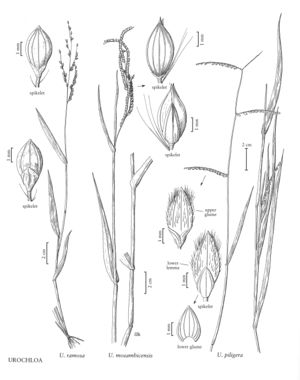Difference between revisions of "Urochloa piligera"
FNA>Volume Importer |
FNA>Volume Importer |
||
| Line 7: | Line 7: | ||
|synonyms={{Treatment/ID/Synonym | |synonyms={{Treatment/ID/Synonym | ||
|name=Brachiaria piligera | |name=Brachiaria piligera | ||
| − | |authority= | + | |authority= |
| + | |rank=species | ||
}} | }} | ||
|hierarchy=Poaceae;Poaceae subfam. Panicoideae;Poaceae tribe Paniceae;Urochloa;Urochloa piligera | |hierarchy=Poaceae;Poaceae subfam. Panicoideae;Poaceae tribe Paniceae;Urochloa;Urochloa piligera | ||
| Line 20: | Line 21: | ||
-->{{Treatment/Body | -->{{Treatment/Body | ||
|distribution=Fla. | |distribution=Fla. | ||
| − | |discussion=<p>Urochloa piligera is an Australian species that has been found in Florida. Webster (1987) stated that U. piligera has glabrous and pubescent forms that are identical except in the presence or absence of spikelet vestiture. Currently, only the pubescent form has been found in the Flora area (Hall 1978). The glabrous form is sometimes confused with U. subquadripara. Urochloa piligera lacks a lower palea, and has larger and, usually, closely overlapping spikelets; U. subquadripara has well-developed paleas and smaller (3.3-3.8 mm), well-separated spikelets.</p> | + | |discussion=<p><i>Urochloa piligera</i> is an Australian species that has been found in Florida. Webster (1987) stated that <i>U. piligera</i> has glabrous and pubescent forms that are identical except in the presence or absence of spikelet vestiture. Currently, only the pubescent form has been found in the Flora area (Hall 1978). The glabrous form is sometimes confused with <i>U. subquadripara</i>. <i>Urochloa piligera</i> lacks a lower palea, and has larger and, usually, closely overlapping spikelets; <i>U. subquadripara</i> has well-developed paleas and smaller (3.3-3.8 mm), well-separated spikelets.</p> |
|tables= | |tables= | ||
|references= | |references= | ||
| Line 29: | Line 30: | ||
-->{{#Taxon: | -->{{#Taxon: | ||
name=Urochloa piligera | name=Urochloa piligera | ||
| − | |||
|authority=(F. Muell. ex Benth.) R.D. Webster | |authority=(F. Muell. ex Benth.) R.D. Webster | ||
|rank=species | |rank=species | ||
| Line 36: | Line 36: | ||
|basionyms= | |basionyms= | ||
|family=Poaceae | |family=Poaceae | ||
| − | |illustrator=Linda A. Vorobik | + | |illustrator=Linda A. Vorobik;Cindy Roché |
| + | |illustration copyright=Utah State University | ||
|distribution=Fla. | |distribution=Fla. | ||
|reference=None | |reference=None | ||
| Line 42: | Line 43: | ||
|publication year= | |publication year= | ||
|special status= | |special status= | ||
| − | |source xml=https:// | + | |source xml=https://jpend@bitbucket.org/aafc-mbb/fna-data-curation.git/src/f50eec43f223ca0e34566be0b046453a0960e173/coarse_grained_fna_xml/V25/V25_1321.xml |
|subfamily=Poaceae subfam. Panicoideae | |subfamily=Poaceae subfam. Panicoideae | ||
|tribe=Poaceae tribe Paniceae | |tribe=Poaceae tribe Paniceae | ||
Revision as of 21:32, 16 December 2019
Plants annual. Culms 15-60 cm, erect or decumbent, sometimes rooting at the lower nodes; nodes glabrous. Sheaths glabrous, margins sometimes ciliate; ligules 0.7-1.5 mm; blades 4-15 cm long, 3-11 mm wide, usually glabrous, sometimes pubescent, margins scabrous. Panicles 3-12 cm, with 3-5 spikelike branches in 2 ranks, smooth or scabrous, glabrous or pubescent; primary branches 2-6 cm, divergent to reflexed, axils glabrous, axes 1.1-1.6 mm wide, flat, winged, without papillose-based hairs, margins smooth or scabrous; secondary branches rarely present; pedicels shorter than the spikelets, scabrous. Spikelets (3.3)3.8-4.9 mm long, 1.5-1.8 mm wide, ellipsoid, solitary, usually overlapping, appressed to the branch axes, pubescent or sometimes glabrous, in 2 rows, sometimes appearing 1-rowed. Glumes separated by 0.3-0.5 mm; lower glumes 1.9-2.7 mm, 9-11-veined, glabrous; upper glumes 3.2-4.1 mm, 7-9-veined, glabrous or pubescent, margins glabrous or pilose, when pilose, the basal hairs shorter than the distal hairs; lower florets sterile; lower lemmas 3.1^1.7 mm, resembling the upper glumes in texture and pubescence, 5-7-veined; lower paleas absent; upper lemmas 2-4 mm, apices recurved, rounded, mucronate; anthers 1.5-1.7 mm. 2n = unknown.
Discussion
Urochloa piligera is an Australian species that has been found in Florida. Webster (1987) stated that U. piligera has glabrous and pubescent forms that are identical except in the presence or absence of spikelet vestiture. Currently, only the pubescent form has been found in the Flora area (Hall 1978). The glabrous form is sometimes confused with U. subquadripara. Urochloa piligera lacks a lower palea, and has larger and, usually, closely overlapping spikelets; U. subquadripara has well-developed paleas and smaller (3.3-3.8 mm), well-separated spikelets.
Selected References
None.
